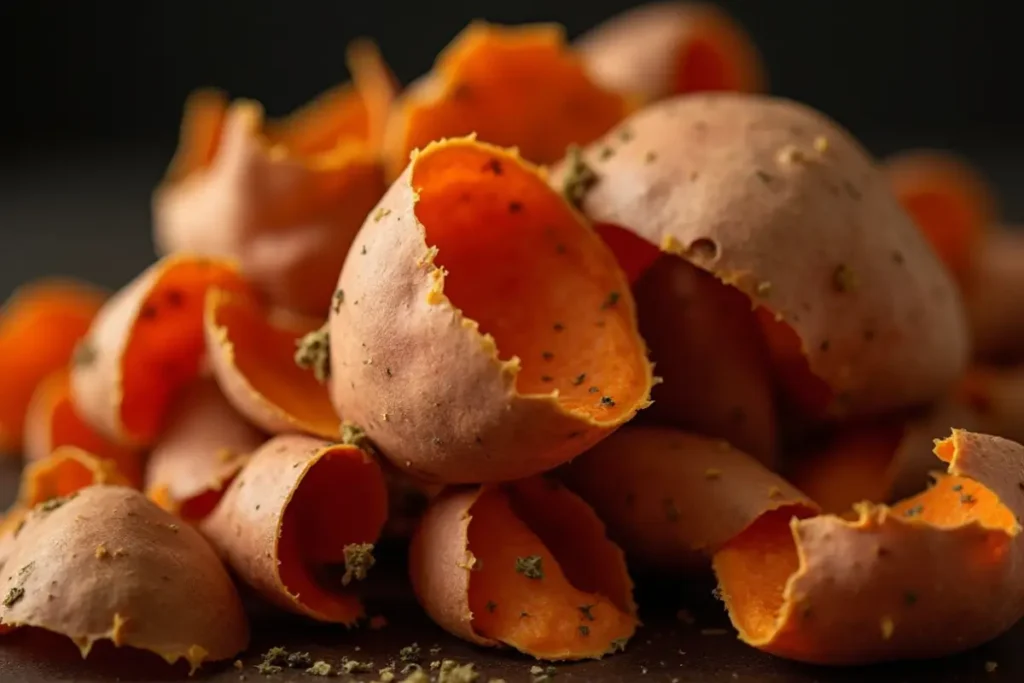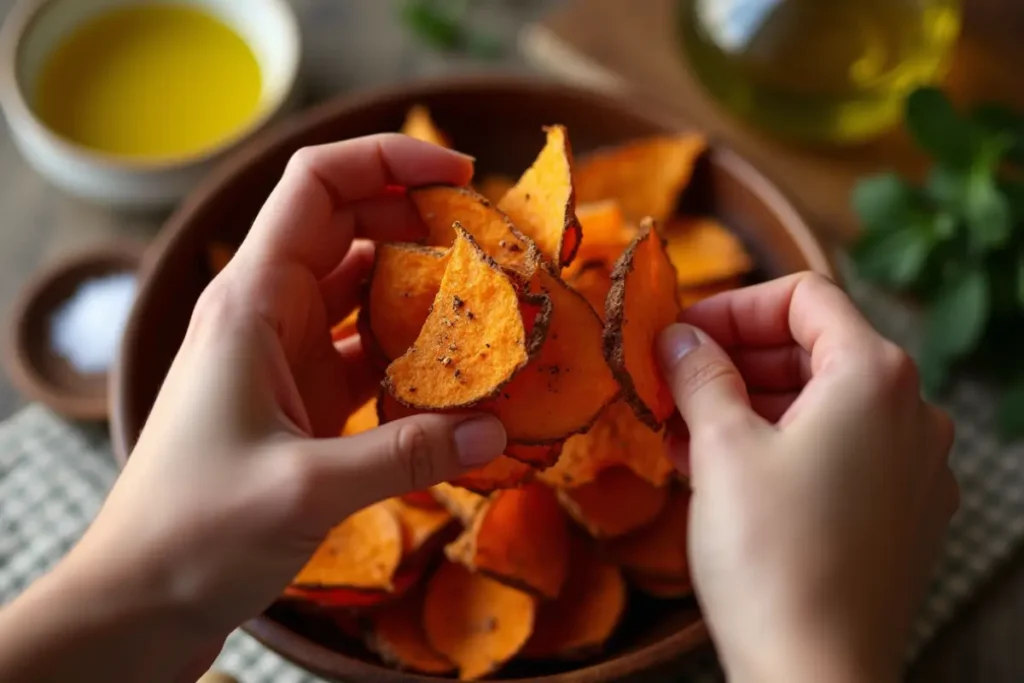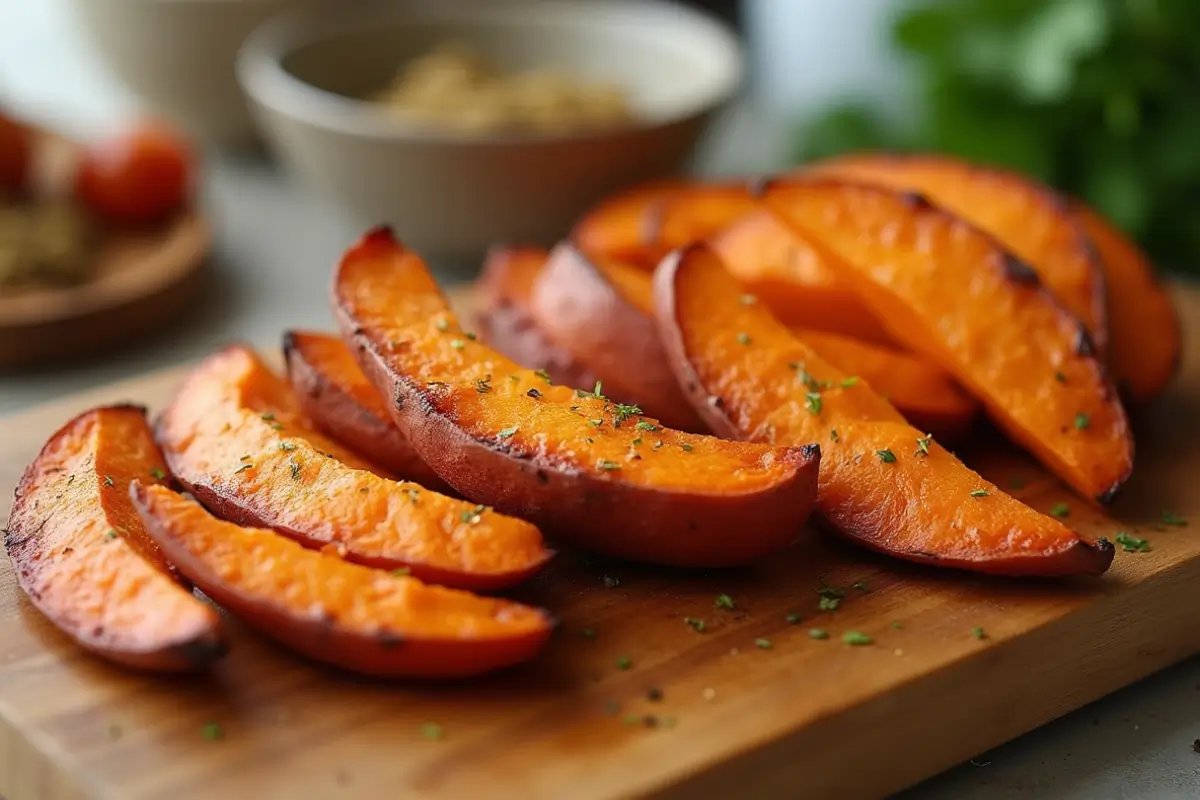Imagine this scene: You’re in your kitchen, ready to cook a delicious meal. The rich, earthy aroma of roasting sweet potatoes fills the air. You’ve prepped the vibrant orange flesh, ready to create something special. But, there’s a pile of peels beside the cutting board. At that moment, you might ask yourself: “Do you eat sweet potato skin?” Is it something you should discard, or is there hidden nutrition you’re missing out on? For years, I, too, discarded it. However, one day, my curiosity got the better of me. Consequently, I decided to investigate. If you’ve ever pondered whether it’s a good idea to eat sweet potato skin, you’re certainly not alone, and I’m here to help you uncover the truth.
The Nutritional Powerhouse Behind the Peel: Why Eating Sweet Potato Skin is Beneficial
The first thing you need to know is that sweet potato skins are not ordinary. In fact, they are surprisingly abundant in essential nutrients that greatly contribute to your health. Indeed, this often-overlooked part of the sweet potato can contain higher concentrations of certain vitamins and minerals than the flesh itself. Therefore, let’s delve into the details.
You probably know the flesh is rich in vitamins, but did you know the skin is also an incredible source of dietary fiber? Fiber is vital for digestion, keeping your gut healthy, and helping you feel full for longer. Therefore, this can be very useful if you’re trying to manage your weight. Moreover, this fiber can also help in regulating your blood sugar levels, preventing spikes.
Besides fiber, sweet potato skins are also a treasure chest of minerals, with potassium as a key player. Potassium aids in maintaining healthy blood pressure and contributes to muscle function. Actually, there is a higher concentration of potassium in the skin compared to the flesh.
Furthermore, we cannot overlook the variety of vitamins within the skin! Notably, it’s an excellent source of Vitamin A, crucial for good vision and immunity. You’ll also be receiving a healthy dose of Vitamin C. This particular vitamin is a powerful antioxidant, helping protect your cells against damage and boosting your immunity.
In addition, this nutritious peel is rich in antioxidants. These neutralize free radicals, which can damage cells. Therefore, by including the skin, you’re adding an extra layer of defense.
In short, including sweet potato skin in your diet isn’t just about minimizing waste; it’s a wise way to enhance your nutrient intake.
Is It Safe to Eat Sweet Potato Skin? Addressing Concerns and Precautions

Now that you understand the nutritional benefits, it’s equally important to consider the safety. Of course, like any other produce, there are precautions you should take. However, these are simple, and once you follow them, you can safely enjoy the healthy peels.
One main concern is pesticide residue and the risk of dirt clinging to the skin. These can pose a risk if consumed, so you should always take care to avoid them. The most important step is to wash your sweet potatoes thoroughly before using them. Use a vegetable brush and cold running water, scrubbing every inch of the skin.
When it comes to pesticides, you might consider choosing organic sweet potatoes. These are grown without synthetic pesticides, making them a safer alternative. Although they may cost a bit more, the investment can be worth it for peace of mind.
Even though allergic reactions to sweet potatoes are rare, it’s always good to be aware of the potential. If you’re trying sweet potato skin for the first time, try it in small amounts, and keep an eye out for unusual symptoms, such as skin rashes or digestive discomfort. It’s also worth mentioning these symptoms could be a result of the increased fiber.
If you are not used to consuming fiber-rich foods, you may notice that eating sweet potato skin can cause some digestive discomfort, like bloating. This is a common reaction, and not something to worry about. Your digestive system needs time to adapt. You can minimize this issue by introducing skins gradually and staying hydrated.
So, to sum up, while the skin is generally safe, be mindful of where your produce comes from, and take all necessary steps to ensure they are clean before consumption.
How to Prepare Sweet Potato Skin: Cooking Methods and Delicious Ideas
Now that you are aware of the benefits and necessary precautions, let’s get into the fun part: how do you prepare sweet potato skin so you can enjoy it to its fullest? The incredible part about this vegetable is how adaptable it is to cooking. Below are some options:
You’ll discover that baking or roasting sweet potatoes with the skin on is very easy and incredibly delicious. The skin becomes beautifully caramelized, with a slightly sweet and crispy texture when roasted at high temperatures. Furthermore, you can bake them whole for a side, or cut them into chunks or wedges if you feel like experimenting. However, make sure the skin has been scrubbed clean.
Alternatively, air frying is a fantastic method. It’s faster than baking, and allows the skin to become wonderfully crispy. Therefore, you should try slicing your sweet potatoes into thick chips or fries for a quick, healthy snack. The high heat will make the skin crispy while keeping the inside soft.
The texture of sweet potato skins can vary depending on how they are cooked. If you like soft skin, consider steaming or boiling them with the flesh. While they will still retain benefits, the skins will be much softer and not crispy. On the other hand, if you like crispy skin, roast them at higher temperatures or use an air fryer. The choice is yours.
Additionally, experimenting with herbs and spices can enhance your sweet potato skin dishes. For a savory side, you can season your sweet potatoes with salt, pepper, garlic powder, paprika, or cumin. If you have a sweet tooth, you can sprinkle cinnamon or nutmeg for a comforting flavor. Therefore, don’t hesitate to create your own recipes.
Sweet Potato Skin Recipes: Beyond the Basics

Now, let’s delve into creative recipes that make the most of the incredible sweet potato skin. Here are a couple of options:
Roasted Sweet Potato with Skin
This basic recipe is a great starting point for enjoying the goodness of sweet potato skin.
| Ingredients | Quantity |
| Sweet Potatoes | 2 |
| Olive Oil | 2 tbsp |
| Salt | 1 tsp |
| Black Pepper | 0.5 tsp |
| Paprika | 0.5 tsp |
Instructions
- Preheat your oven to 400°F (200°C).
- Wash your sweet potatoes carefully.
- Cut the sweet potatoes into uniform chunks or wedges, ensuring you leave the skin intact.
- Place the potatoes in a bowl and toss them with olive oil, salt, pepper, and paprika.
- Spread them on a baking sheet.
- Roast for 20-30 minutes, or until they are tender and golden brown.
- Serve as a side dish or incorporate them into other recipes.
Sweet Potato Skin Chips
This recipe is a fantastic option for turning sweet potato peels into a crispy snack.
| Ingredients | Quantity |
| Sweet Potato Skins | 2 |
| Olive Oil | 1 tbsp |
| Salt | 0.5 tsp |
| Garlic Powder | 0.25 tsp |
| Onion Powder | 0.25 tsp |
Instructions
- Preheat your oven to 350°F (175°C).
- After peeling your sweet potatoes, wash the skins and dry them thoroughly.
- In a bowl, toss the skins with olive oil, salt, garlic powder, and onion powder.
- Spread the skins in a single layer on a baking sheet.
- Bake for 10-15 minutes, until they are nice and crispy.
- Watch them carefully so they don’t burn, and you’ll have a tasty, healthy snack.
Beyond these, you should also experiment with stuffed sweet potato skins. After roasting your sweet potatoes, scoop out the flesh and leave the skins to become crispy. Then, fill them with veggies, beans, spices, and even a little cheese. You can also try making sweet potato skin fries with a blend of your favorite spices.
In conclusion, you should never let the peels of the sweet potato go to waste. They are packed with goodness and super adaptable to most dishes. Therefore, don’t be afraid to come up with your own recipes.
Other Uses for Sweet Potato Skins: Reducing Food Waste
If, for any reason, you’re not ready to eat sweet potato skins, there are other options. Indeed, one of the best is to compost them.
Composting is a great way to turn kitchen waste into nutrient-rich soil for your plants, helping to minimize food waste and reduce your carbon footprint. Simply add sweet potato skins to your compost bin along with other scraps, and over time, they will break down into valuable compost. This is not only good for the environment but also a useful way to nourish your garden.
By being mindful of how you consume food and seeking ways to reuse and repurpose leftovers, you can also make a major impact on reducing food waste. Furthermore, it’s vital that you are aware of the resources that go into the production of your food, and do your best to honor it by not letting any of it go to waste. Reducing waste is good for our pockets and our planet.
In other words, even if you cannot eat them, sweet potato skins are not useless. Rather, they can become amazing fertilizer that helps enrich your garden, or they can simply be an opportunity to be more environmentally conscious. Thus, they should never be wasted.
What Sides Go With Sweet Potato Skin?
Sweet potato skins are a delightful and nutrient-rich dish that can shine as a snack, appetizer, or main course. Pairing them with the right sides can enhance the meal. Here are some top suggestions:
1. Sweet and Savory Combinations
To balance the earthy flavors of sweet potato skins, add a sweet and decadent pairing like Brookie Recipe. The mix of brownies and cookies complements the natural sweetness of the dish.
2. Rice-Based Dishes
Rice dishes such as pilaf or herbed rice provide a hearty base that pairs well with the creamy texture of sweet potato skins. Explore Rice Cooker Meals for easy-to-make options that are versatile and flavorful.
3. Creamy Toppings
For a touch of indulgence, top your sweet potato skins with whipped cream or a cheesy drizzle. Learn how to make your own creamy toppings with Homemade Heavy Cream for a customized finish.
4. Savory Flatbreads
Adding bread to the plate can round out your meal. For a tangy and unique twist, serve Cottage Cheese Flatbread alongside your sweet potato skins for a complementary texture and flavor.
5. Educational Pairings
For those curious about the difference between sweet potatoes and yams, check out What Is the Difference Between Sweet Potatoes and Yams?. Understanding these distinctions can inspire creative pairings and variations.
By incorporating these sides and enhancements, sweet potato skins can become the centerpiece of a meal or a memorable snack. Pair them thoughtfully to suit any occasion!
Frequently Asked Questions About Eating Sweet Potato Skin
It’s always good to have answers to common questions:
- Is it safe for everyone to eat sweet potato skin?
- For the most part, people can safely consume sweet potato skin. However, it is important to ensure they are thoroughly washed and cleaned. If you have specific allergies or are unsure about how your body might react to the increased fiber, try small quantities first or consult with a healthcare provider.
- Do you eat sweet potato skin raw?
- Although you can technically eat sweet potato skin raw, it’s much more enjoyable and palatable when cooked. Cooking will soften the skin, making it easier to digest, and enhancing its flavors.
- Can eating sweet potato skin cause any digestive issues?
- Because sweet potato skin is packed with a high amount of fiber, some may experience temporary digestive discomfort, such as bloating or gas, especially if they aren’t used to fiber-rich food. To avoid this, ensure you introduce them gradually and stay hydrated.
- How do I ensure I have thoroughly washed the skins of sweet potatoes before cooking?
- Scrub the sweet potatoes under cold running water, using a vegetable brush. Pay special attention to the crevices. Then, pat them dry with a clean towel before cooking.
- What kind of sweet potato skin is the healthiest to eat?
- The nutritional benefits are very similar, whether they are white or orange-fleshed. However, some varieties may have thicker skins, meaning you may receive a higher dose of nutrients. Also, it’s a good idea to try to purchase organic sweet potatoes to reduce your exposure to pesticides.
Conclusion
So, as we end this exploration of sweet potato skins, it’s clear that these often-discarded parts of the vegetable are not just waste; they are a powerhouse of nutrition. When you choose to incorporate them into your diet, you boost your nutrient intake, maximizing your vegetable and your time in the kitchen.
Therefore, don’t be afraid to experiment with them, as they are versatile, and the culinary opportunities are endless. The benefits of eating sweet potato skin extend beyond just health; they represent a step towards reducing waste and adopting a more sustainable lifestyle.
Therefore, the next time you prepare sweet potatoes, don’t toss the skins. Embrace their nutritional value, their versatility, and the opportunity to positively impact your health and the environment. Go ahead, let your creativity flow, try out the incredible dishes waiting for you, and enjoy the healthy benefits that sweet potato skin offers.

